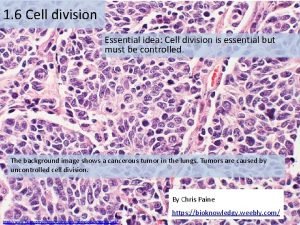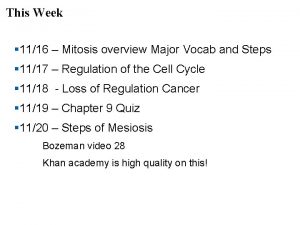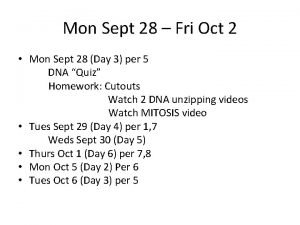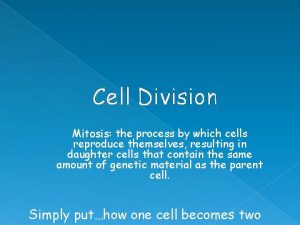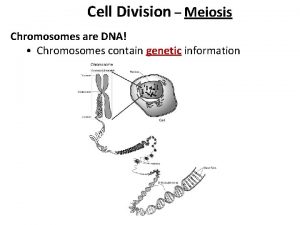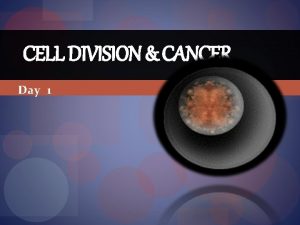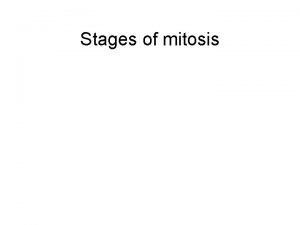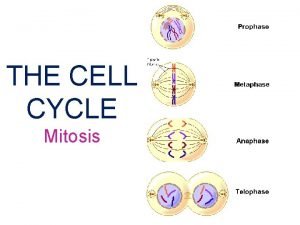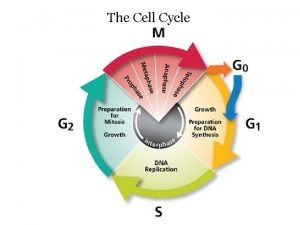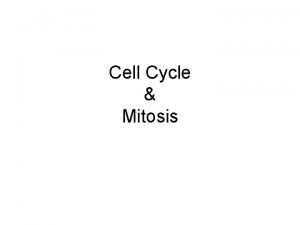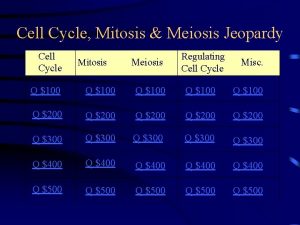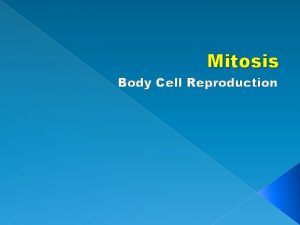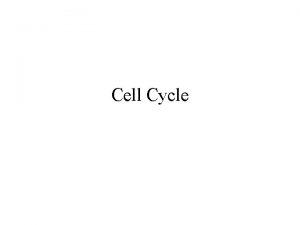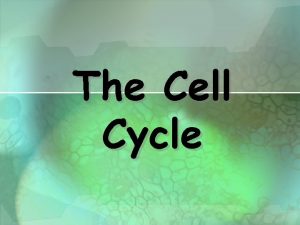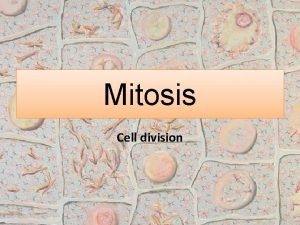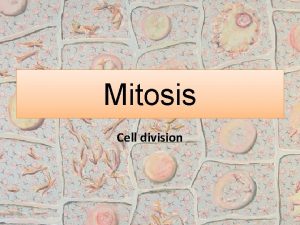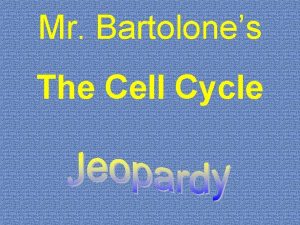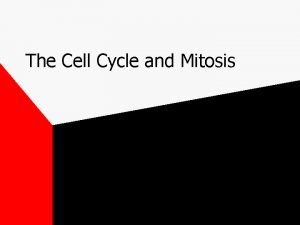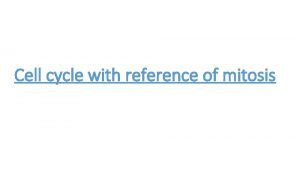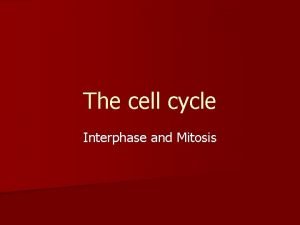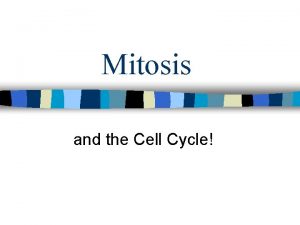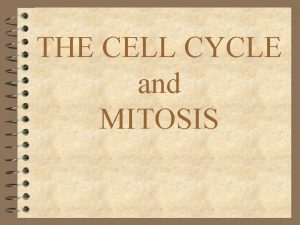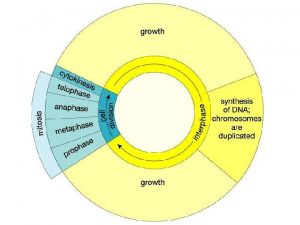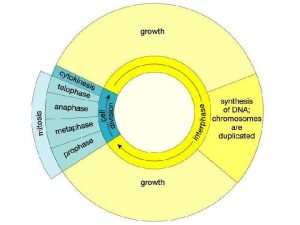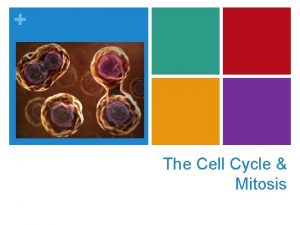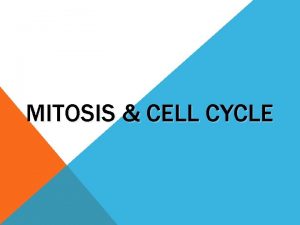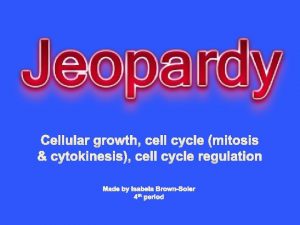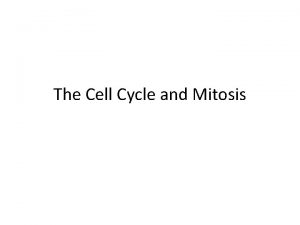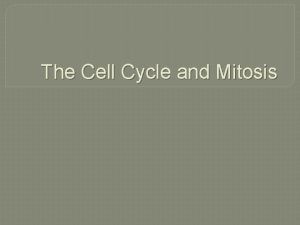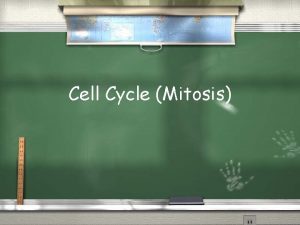Chapter 12 The Cell Cycle Mitosis Mitosis is



































































- Slides: 67

Chapter 12 The Cell Cycle

Mitosis • Mitosis is the division of the nucleus into two genetically identical daughter nuclei. • The result is two cells that are exactly alike--clones of one another.

Mitosis • During mitosis, the sister chromatids separate, the nucleus divides, and cytokinesis separates the cytoplasm of the cell. • Each new cell now contains one copy of DNA from the parent cell and the cycle repeats.

Mitosis • During mitosis, the genetic material is duplicated and then division occurs producing two identical daughter cells. • When the chromosome has duplicated and the two pieces are attached at the centromere, they are referred to as sister chromatids.

Mitosis • After anaphase, when the sister chromatids have separated, the structures are now referred to as chromosomes.

The Genome • The genome is all of the genetic material contained within the DNA of an organism. • Most prokaryotes contain a single strand of circular DNA • Most Eukaryotes have multiple linear strands of DNA.

Chromosomes • Chromosomes are the structures that make DNA replication and distribution manageable. • The name chromosome comes from their ability to take up dye when being prepared for microscopy. • All eukaryotes have a characteristic number of chromosomes contained within the nucleus of the cell.

Chromatin and Eukaryotic Cells • The chromosomes of eukaryotic cells are made up of chromatin. • Chromatin is composed of DNA and associated proteins.

Chromatin and Eukaryotic Cells • The DNA found on each chromosome contains a few hundred to a few thousand genes specifying an organism’s traits. • The associated proteins help to maintain the structure of the chromosome and control the activity of the genes.

Mitosis • There are essentially two types of cells when it comes to mitosis: • 1. Non-dividing • 2. Dividing

1. Non-Dividing Cells • During this time, the chromatin of each chromosome is in a long thin configuration distributed throughout the cell. • The cell is doing its job. • The cell is preparing to divide.

1. Non-Dividing Cells • During interphase, DNA is duplicated in preparation for cell division and when finished, the chromatin begins to condense--or become “supercoiled”.

2. Dividing Cells • Once the chromosome has been duplicated, there are now 2 sister chromatids which contain identical DNA molecules and are attached by proteins along their lengths. • The region where the sister chromatids appear to be pinched together is called the centromere.


2 Main Phases of the Cell Cycle • Interphase which is broken into: • G 1 • S-Phase • G 2 • Mitosis (M-Phase) which is broken into: • • • Prophase Prometaphase Metaphase Anaphase Telophase Cytokinesis


Interphase • During the G 1 phase, a log of genes are turned on in order to make proteins necessary to run the metabolism of the cell. • This includes generating enzymes to breakdown carbohydrates, lipids, proteins, etc. • Additionally, the cell grows during this stage.

Interphase • During the S-phase, a variety of enzymes are involved in the synthesis of DNA via the semi-conservative method. • Think DNA Synthesis!

Interphase • In G 2, the cells prepare for division. • Many different proteins are made that will act as spindle fibers (protein ropes). • Organelles grow and divide and increase in number so each cell ends up with some. • Towards the end of G 2, things slow down as the cell readies for division.

Mitosis-Prophase • Prophase is when the chromatin becomes tightly coiled.

Prophase • Prophase

Mitosis Prometaphase • Prometaphase is when each chromosome is distinctly visible and the nuclear envelope breaks down.

Mitosis Prometaphase • Prometaphase

Mitosis-Metaphase • Metaphase is when the c-somes align at the metaphase plate.

Mitosis-Metaphase • Metaphase

Anaphase • As the proteins which bind the sister chromatids together become inactivated, sister chromatids start to separate and begin moving to opposite ends of the cell. • Motor proteins move the chromatids to the poles of the cell.

Mitosis-Anaphase • Anaphase occurs when sister chromatids begin to move apart.

Anaphase • Anaphase

Mitosis-Telophase • Telophase occurs when the 2 daughter nuclei begin to form.

Telophase • Telophase

Mitosis-Cytokinesis • Cytokinesis occurs when a cleavage furrow forms and pinches the cell into two new daughter cells. http: //imgarcade. com/1/cytokinesis-in-plant-cells-microscope/

Cytokinesis in Animals • During cytokinesis, a cleavage furrow forms and cleaves the cell into 2 new cells. • The cleavage furrow forms as a contractile ring of actin microfilaments interacts with myosin molecules on the cytoplasmic side of the plasma membrane. • When this interaction occurs, the ring contracts pinching the cell in two.


Cytokinesis in Plants • In plants, cytokinesis is much different. No cleavage furrow forms. Instead, vesicles which come from the Golgi migrate along microtubules to the center of the cell after division of the cytoplasmic contents. • The vesicles which collect at the center of the cell form a cell plate which eventually becomes a cell wall and two new cells are formed.


Cytokinesis • Cytokinesis


Interphase and Centrosomes • The centrosomes are nonmembranous organelles which organize the microtubules. • Sometimes the centrosomes are called the microtubule organizing center. • During interphase they duplicate and move to opposite ends of the cell.

Prophase and Centrosomes • As the centrosomes are moving to opposite ends of the cell (prophase and prometaphase are now occurring), microtubules grow out from them and attach to the kinetochore on each sister chromatid. • After attachment, each sister chromatid begins to move toward the pole from which the microtubule extends.

Centrosomes and Prophase • The actual movement of the chromatids is prevented because of the binding of the microtubule from the opposite end of the cell. • A “tug-of-war” now takes place until the c-somes are aligned at the metaphase plate.

Mitotic Spindle • The mitotic spindle is an important part mitosis because it is the organized array of microtubules that moves the chromosomes during cell division.



Stages of the Cell Cycle • The various stages of the cell cycle are determined by a variety of cytoplasmic signals. • This evidence comes from cell-fusion experiments performed in the early 1970’s. • It is often referred to as the Cell Cycle Control System. • When this system is active, the cell replicates its DNA, elongates, and the plasma membrane grows inward dividing the cell in two.

Cell Cycle Control System • This system cyclically operates and controls the key events in the cell cycle. • Each of the phases of the cell cycle seem to be controlled by a checkpoint which is where critical stop-and-go signals regulate the cell cycle. • Cytoplasmic signals govern the cell cycle control system.

Regulatory Proteins • Cyclins and Kinases are the two main types of regulatory molecules (proteins) found in cells. • They work together to regulate the activation of the signaling molecules involved in DNA synthesis and mitosis. • Their levels rise and fall throughout the course of the cell cycle.


Cyclins • Cyclins are a family of proteins that interact with kinases to control the cell cycle. • They do so by activating cyclindependent kinase enzymes that, in turn, set off a series of signals resulting in a cellular response: DNA synthesis, protein synthesis, cell division, etc.

Kinases • Kinases are enzymes that function by either activating or inactivating other proteins by phosphorylation. • These activated proteins carry out a variety of functions in addition to giving “go” signals at the G 1 and G 2 checkpoints.

Kinases • Kinases are usually present in constant concentration within the cell, but are inactive. • They become active when a particular cyclin protein binds to them. • These kinases are called cyclin dependent kinases or Cd. Ks for short. • The cyclin-Cdk complex activation is what triggers events in the cell cycle.

Cyclin-Kinase Interactions • When cyclins and kinases interact, they initiate a variety of conformational changes in the associated protein. These changes lead to an effect within the cell.

Cyclin-Kinase Interactions • For example, at the beginning of mitosis, Cdk activity increases leading to the increased phosphorylation of proteins controlling chromosome condensation, nuclear envelope breakdown, and spindle assembly.

For Example: • Cdk associates with different cyclins triggering different events of the cell cycle. • For simplicity, only the cyclins that act in the S phase and M phase are shown here. http: //www. ncbi. nlm. nih. gov/books/NBK 26824/

Classes of Cyclins: • There are four major classes of cyclins that push the cell through the cell cycle: • G 1/S-cyclins-bind Cdks at the end of G 1 and commit the cell to DNA replication. • S-cyclins-bind Cdks during the S-phase and are required for DNA replication. • M-cyclins-promote events of mitosis. • G 1 -cyclins-promote passage through G 1.

Cell Cycle Control System • The cyclin signals shut down certain aspects of the cell cycle while starting others once key cellular processes have been completed. • The checkpoints are: • G 1/S Checkpoint • G 2/M Checkpoint • There are two intra-phase checkpoints: • Intra-S-phase Checkpoint • Spindle Assembly (M) Checkpoint


G 1/S Checkpoint • For many cells, G 1 is important because it is here where if cells receive a “go” signal, they will usually go through S, G 2 and M. • It is sometimes dubbed the “restriction point. ” • If no go signal is received, the cell enters G 0 which is a phase of non-division.

G 1/S Checkpoint • During G 1, there a variety of cyclinkinase reactions that result in the transcription of genes that make proteins which promote entry into the S-phase. • If damage to the DNA occurs, several mechanisms are in place which halt the cell cycle in G 1. • These mechanisms are associated with several gene products--proteins.

G 0 Quiescence • Most cells in the human body are in the G 0 phase and only very rarely divide (mature nerve and muscle cells). • Others are in G 0, but can be stimulated to divide when needed, such as after an injury (liver).

Intra-S-Phase Checkpoint • The intra-S-phase checkpoint acts as a surveillance camera. • During the S-phase, any problems with DNA replication trigger this checkpoint. • This checkpoint results in a cascade of signaling events that puts this and the next phase on hold until the problem is resolved.

Intra-S-Phase Checkpoint • When the replication fork encounters damaged DNA, protein kinase pathways are activated. • This prevents the formation of new replication forks stopping DNA synthesis and arresting mitosis. • The involved protein kinases also act to stabilize the replication fork while the DNA is being repaired.

Intra-S-Phase Checkpoint • If repairs cannot be made, either cell cycle arrest occurs, or apoptosis ensues.

G 2/M Checkpoint • This checkpoint is sometimes called the DNA damage checkpoint, and it ensures that the cell has successfully replicated its DNA. • If errors are detected, various cyclindependent kinase pathways will hold the cell in G 2 until the damage has been fixed.

G 2/M Checkpoint • During G 2, cells produce M-cyclin molecules that interact with various kinases and promote entry of the cell into the M-phase (mitosis). • The interaction of particular cyclins with kinases at G 2 will form MPF and stimulate entry into M-phase.

G 2/M Checkpoint

Spindle Assembly (M) Checkpoint • This checkpoint occurs during metaphase, and senses the tension caused by the attachment of the microtubules to the chromosomes. • When this tension is sensed, a variety of cyclin-kinase pathways are stimulated promoting the completion of mitosis and re-entry into G 1.

The Effects of a Faulty Cell Cycle • During the next discussion, you will learn what happens when the cell cycle doesn’t function properly.
 Mitosis and cell cycle terminology
Mitosis and cell cycle terminology Mitosis meiosis concept map
Mitosis meiosis concept map Cell division phases
Cell division phases Events of the cell cycle
Events of the cell cycle Cell cycle and cell division
Cell cycle and cell division Biology.arizona.edu/cell bio/activities/cell cycle/01.html
Biology.arizona.edu/cell bio/activities/cell cycle/01.html Painting
Painting Chapter 4 cell theory and cell study
Chapter 4 cell theory and cell study Anaphase
Anaphase Mitosis number of chromosomes in each stage
Mitosis number of chromosomes in each stage Cell division mitosis and meiosis
Cell division mitosis and meiosis Number of chromosomes in meiosis
Number of chromosomes in meiosis Cell mitosis
Cell mitosis What phase of mitosis is this cell in?
What phase of mitosis is this cell in? Two cells are produced
Two cells are produced Cell in interphase labeled
Cell in interphase labeled Youtube.com
Youtube.com Mitosis bingo
Mitosis bingo When do spindle fibers first become visible brainpop
When do spindle fibers first become visible brainpop Chapter 5 principles of engine operation
Chapter 5 principles of engine operation Hát kết hợp bộ gõ cơ thể
Hát kết hợp bộ gõ cơ thể Frameset trong html5
Frameset trong html5 Bổ thể
Bổ thể Tỉ lệ cơ thể trẻ em
Tỉ lệ cơ thể trẻ em Voi kéo gỗ như thế nào
Voi kéo gỗ như thế nào Chụp tư thế worms-breton
Chụp tư thế worms-breton Hát lên người ơi alleluia
Hát lên người ơi alleluia Môn thể thao bắt đầu bằng từ đua
Môn thể thao bắt đầu bằng từ đua Thế nào là hệ số cao nhất
Thế nào là hệ số cao nhất Các châu lục và đại dương trên thế giới
Các châu lục và đại dương trên thế giới Công thức tiính động năng
Công thức tiính động năng Trời xanh đây là của chúng ta thể thơ
Trời xanh đây là của chúng ta thể thơ Mật thư tọa độ 5x5
Mật thư tọa độ 5x5 Làm thế nào để 102-1=99
Làm thế nào để 102-1=99 Phản ứng thế ankan
Phản ứng thế ankan Các châu lục và đại dương trên thế giới
Các châu lục và đại dương trên thế giới Thơ thất ngôn tứ tuyệt đường luật
Thơ thất ngôn tứ tuyệt đường luật Quá trình desamine hóa có thể tạo ra
Quá trình desamine hóa có thể tạo ra Một số thể thơ truyền thống
Một số thể thơ truyền thống Bàn tay mà dây bẩn
Bàn tay mà dây bẩn Vẽ hình chiếu vuông góc của vật thể sau
Vẽ hình chiếu vuông góc của vật thể sau Thế nào là sự mỏi cơ
Thế nào là sự mỏi cơ đặc điểm cơ thể của người tối cổ
đặc điểm cơ thể của người tối cổ Thế nào là giọng cùng tên?
Thế nào là giọng cùng tên? Vẽ hình chiếu đứng bằng cạnh của vật thể
Vẽ hình chiếu đứng bằng cạnh của vật thể Vẽ hình chiếu vuông góc của vật thể sau
Vẽ hình chiếu vuông góc của vật thể sau Thẻ vin
Thẻ vin đại từ thay thế
đại từ thay thế điện thế nghỉ
điện thế nghỉ Tư thế ngồi viết
Tư thế ngồi viết Diễn thế sinh thái là
Diễn thế sinh thái là Các loại đột biến cấu trúc nhiễm sắc thể
Các loại đột biến cấu trúc nhiễm sắc thể Số.nguyên tố
Số.nguyên tố Tư thế ngồi viết
Tư thế ngồi viết Lời thề hippocrates
Lời thề hippocrates Thiếu nhi thế giới liên hoan
Thiếu nhi thế giới liên hoan ưu thế lai là gì
ưu thế lai là gì Khi nào hổ mẹ dạy hổ con săn mồi
Khi nào hổ mẹ dạy hổ con săn mồi Khi nào hổ mẹ dạy hổ con săn mồi
Khi nào hổ mẹ dạy hổ con săn mồi Sơ đồ cơ thể người
Sơ đồ cơ thể người Từ ngữ thể hiện lòng nhân hậu
Từ ngữ thể hiện lòng nhân hậu Thế nào là mạng điện lắp đặt kiểu nổi
Thế nào là mạng điện lắp đặt kiểu nổi Golgi body school analogy
Golgi body school analogy Difference between mercury cell and diaphragm cell
Difference between mercury cell and diaphragm cell Prokaryotic cell vs eukaryotic cell
Prokaryotic cell vs eukaryotic cell Linear chromosomes in eukaryotes
Linear chromosomes in eukaryotes Plant vs animal cells organelles
Plant vs animal cells organelles Lithium ion battery reaction equation
Lithium ion battery reaction equation
